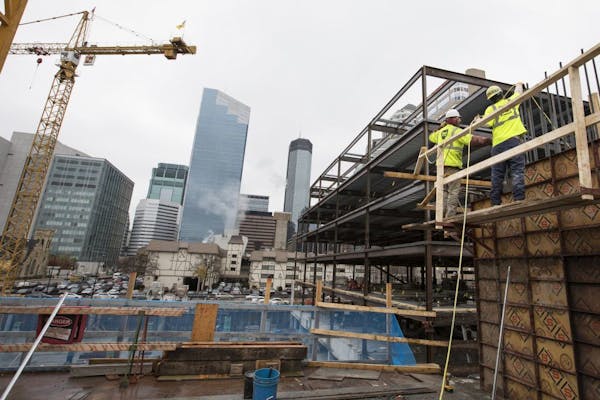Demand for rental apartments in the Twin Cities metro continues to defy expectations.
Across the 13-county metro, the average vacancy rate declined to 2.5 percent during the third quarter, according to a report from Marquette Advisors.
That was down from 2.9 percent during the previous quarter and a slight increase compared with last year.
Vacancies have remained below 3 percent for several consecutive quarters despite a broad presumption that an influx of new units would put a drag on the absorption of new units.
"Yes, it is somewhat surprising," said Mary Bujold, president of Maxfield Research. "There are still a number of projects that have not yet been delivered, which may make a difference once they come online."
With demand on the rise and luxury rentals flooding the market, renters are paying more, but maybe not as much as the data might suggest.
Marquette's Apartment Trends report said the average market rent was $1,091, a 5.4 percent increase compared with last year. Because so many of the new units that have come online are luxury units, much of that increase was a change from the typical mix of properties.
The report noted that the 5.4 percent increase does not represent a pure "same store" growth rate.
Marquette had predicted that by now, the metro-area vacancy rate would have climbed into the mid- to-upper 3 percent range, but that has yet to happen.
"Considering that trend paired with some delays in several projects that are under construction, it is likely that market vacancy will continue to hover around 3 percent or slightly higher by the end of the year," Bujold said.
The Marquette report said absorption of new units across the metro increased notably during the quarter, when 1,490 units were rented compared with 902 units during the first half of the year. Total absorption is likely to exceed 2,500 units by the end of the year, but far short of what was absorbed last year.
Though the apartment development boom has been shifting from both downtowns to the suburbs, there are still several major projects in the pipeline in both cities, which also posted some of the biggest increases in rents.
In downtown Minneapolis, for example, the average vacancy rate was 5.3 percent, down 2 percentage points from last year. Absorption in the area accounted for nearly a quarter of all new units in the metro.
The same was true in downtown St. Paul, where demand has been strong, but construction has been relatively controlled. The average vacancy increased slightly to 5.9 percent with the average rent increasing 7.6 percent. So far this year, that submarket has absorbed about 140 units with another 300 units expected by the end of the year.
Such gains across the metro area are being driven by a growing number of renters by choice, but the depth of that pool is unknown. In recent years the size of that group has swelled as baby boomers retire and young professionals seek the flexibility of a lease rather than a mortgage.
But there has been some evidence that an increase in household growth and the aging of millennials is helping to stem losses in the national homeownership rate. Late last month, the U.S. Census Bureau said the homeownership rate of 63.5 percent during the third quarter was not statistically different from the same time last year.
Zillow Chief Economist Svenja Gudell said that a modest uptick in the homeownership rate was driven by almost 1 million new homeowner households and a drop in renter households of more than 600,000 between the second and third quarters.
"There has been a lot of hand wringing lately about the declining homeownership rate and slowing household formation rate, but this quarter's data prove that homeownership is stabilizing and buying a home remains an important goal for millions of Americans," she said in a statement.
Valerie Doleman, vice president for marketing and communications for Twin Cities-based Sherman Associates, said that occupancy throughout the company's entire portfolio in the Twin Cities has remained high — about 96 percent. She said that leasing activity has remained strong, but with several high-end projects currently in lease-up, renters have been pondering their decision.
The company is putting the finishing touches on the Encore, a luxury 12-story rental building overlooking Gold Medal Park and the Mississippi River in the Mill District. The building has the kinds of finishes that are typically found in upscale for-sale condos, which are in short supply in the metro.
That includes wood floors, gas ranges and gas lines on the balconies. Rents range from $1,780 for a studio to $8,600 for a penthouse unit. Though move-ins won't start until December, the building is 12 percent pre-leased.
"People are requiring more time to make a decision," she said. "We have adjusted our marketing strategy to better help them in their decision process."
Jim Buchta • 612-673-7376
